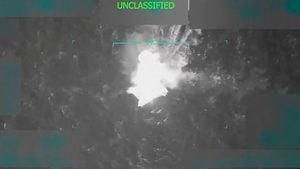In a dramatic turn of events, the ongoing wildfire situation surrounding Jasper National Park has escalated, prompting thousands to flee as flames edge closer to the historic Canadian mountain town. What began as a few isolated fires morphed into a significant crisis, leading to an urgent evacuation order issued late Monday night. As the clock struck ten, the breath-taking vistas of Jasper, known for its stunning natural beauty, were obscured by smoke and the threat of flames.
Evacuation details revealed chaos on the mountain roads, as both residents and tourists were forced to navigate their escape through dark, smoke-filled highways toward British Columbia. With over 10,000 individuals—including approximately 4,700 town residents and 15,000 visitors trapped in the park—hearts raced as vehicles lined the roads, headlights illuminating the ominous haze ahead.
For many, this summer trip to Jasper had been a meticulously planned highlight, but for families like the Goertzes from Ontario, excitement quickly turned into fear. Parents scrambling to awaken their sleeping children tossed aside vacation bags as they prepared to evacuate through a landscape thick with ashes. “I didn’t realize how close it was until we saw the flames,” recalled Stephanie Goertz, who was caught off-guard by the rapid worsening of the situation. “We had to move fast; the way the winds were blowing, we didn’t know how quickly the fire would spread.
The urgency to evacuate prompted Alberta's Public Safety Minister Mike Ellis to instruct evacuees to take detoured routes, either north towards Grande Prairie or south via Kamloops, saying, "B.C. has its hands full with its own wildfires and evacuations." Those redirected had no choice but to log a staggering journey, spanning over 900 kilometers in some cases, all while smoke choked the air and the scent of burning wood pricked their senses.
The pivotal moment came around 10 PM Monday when authorities declared a state of emergency. Winds gusting upwards of 20-30 kilometers per hour exacerbated the danger, as fire management officer Katie Ellsworth explained, “These fires were exhibiting aggressive fire behaviour.” Officials faced significant hurdles, having to expedite the evacuation of both the town and countless campers amidst catastrophic conditions.
For the small community of Valemount, which sits about 120 kilometers west of Jasper, the strain of absorbing hundreds of evacuees has been palpable. Anne Yanciw, town administrator, said they made every effort to accommodate the influx of individuals seeking refuge. “Every parking lot, boulevard, side of the road... anything that looks like it could fit a vehicle is full,” she remarked, describing the overwhelming response from locals eager to help. “It’s all hands on deck.” Evacuees crammed into local arenas, community centers, and even parked outside with nowhere to go, prompting pantry runs by the locals armed with pancakes and coffee.
Yet the mountainous terrain proved perilous. As the fires grew raging and unpredictable, the chances of safely maneuvering logistics became daunting. Residents familiar with the area expressed concern, with one woman observing, “Golden hours turned into terrifying nights.” The fires, primarily lit by a series of lightning storms, spread dangerously close to the townsite, forcing authorities to continuously update evacuation routes and resources.
Parks Canada confirmed by Tuesday morning that many backcountry campers were still located in remote areas as crews mobilized helicopter resources to attempt their evacuation. “We can’t be 100% sure of how many hikers are still in there, but those with permits should have been evacuated by now,” said Ellsworth. “Unfortunately, individuals who do not have reservations can be difficult to locate.” The proactive measures had no historical precedent in Jasper National Park, home to breathtaking trails and scenic exploits typically buzzing with summer tourism.
The government’s swift action included door-to-door inquiries to ensure safety compliance, instigated by fears that some elderly locals might remain oblivious or unprepared for the critiquing situation. As the day progressed, frustration mounted due to conflicting communication from the province regarding the time frame for the evacuations, as Ellis stated, "A lot of people were scared, and we needed to ensure clarity." Official figures point to nearly 25,000 individuals who sought safer ground as the emergency unfolded.
The tangled situation came to a head for some families who were vacationing at the park. Jessica Jackson described her terrifying experience navigating the crisis with two young children as flames loomed closer. “It took us two hours to get out of our neighborhood just to get to the highway, we could see the fires creeping in from all sides,” she recounted. The Jacksons ended up in Valemount, where they joined multitudes hoping to find sanctuary amidst chaos.
No one could predict that the unassuming summer vacation would turn into a battle for safety, yet Jasper eloquently illustrated the unpredictable nature of wildfires—and the courage of a community responding to a dire need. With the fire situation dynamic and evolving rapidly, community leaders like Jasper’s Mayor Richard Ireland struggled to uphold morale. "This is an extremely complex situation that is rapidly evolving,” he said emphasizes that stability would be their primary goal.
By Wednesday, rescue efforts were trending toward positive outcomes. A dedicated team worked diligently to secure the last remaining backcountry hikers while authorities pledged to keep providing safe avenues of evacuation and accommodation. Parks Canada vowed to enhance firefighting teams and aircraft in order to sprout effective containment strategies.
The calamity in Jasper echoes an urgent reminder of the significant climatic trends affecting wildfires in North America, with Alberta facing a staggering 170 active wildfires by midweek. With dry conditions dominating, officials remained vigilant and resolved to steer the province through perilous times. As citizens of Jasper resumed their lives amid uncertainty, the future of the park—and its storied wilderness—remains precariously at stake. Can resilience shine through the smoke? With a watchful eye on the parched landscapes, communities across Alberta will likely face this question as they emerge from the depths of an extraordinary environmental crisis.



